作为一名程序员,经常要搜一些教程,有的教程是在线的,不提供离线版本,这就有些局限了。那么同样作为一名程序员,遇到问题就应该解决它,今天就来将在线教程保存为PDF以供查阅。
1、网站介绍2、准备工作2.1 软件安装2.2 库安装3、爬取内容3.1 获取教程名称3.2 获取目录及对应网址3.3 获取章节内容3.4 保存pdf3.5 合并pdf4、完整代码
1、网站介绍
之前再搜资料的时候经常会跳转到如下图所示的在线教程:
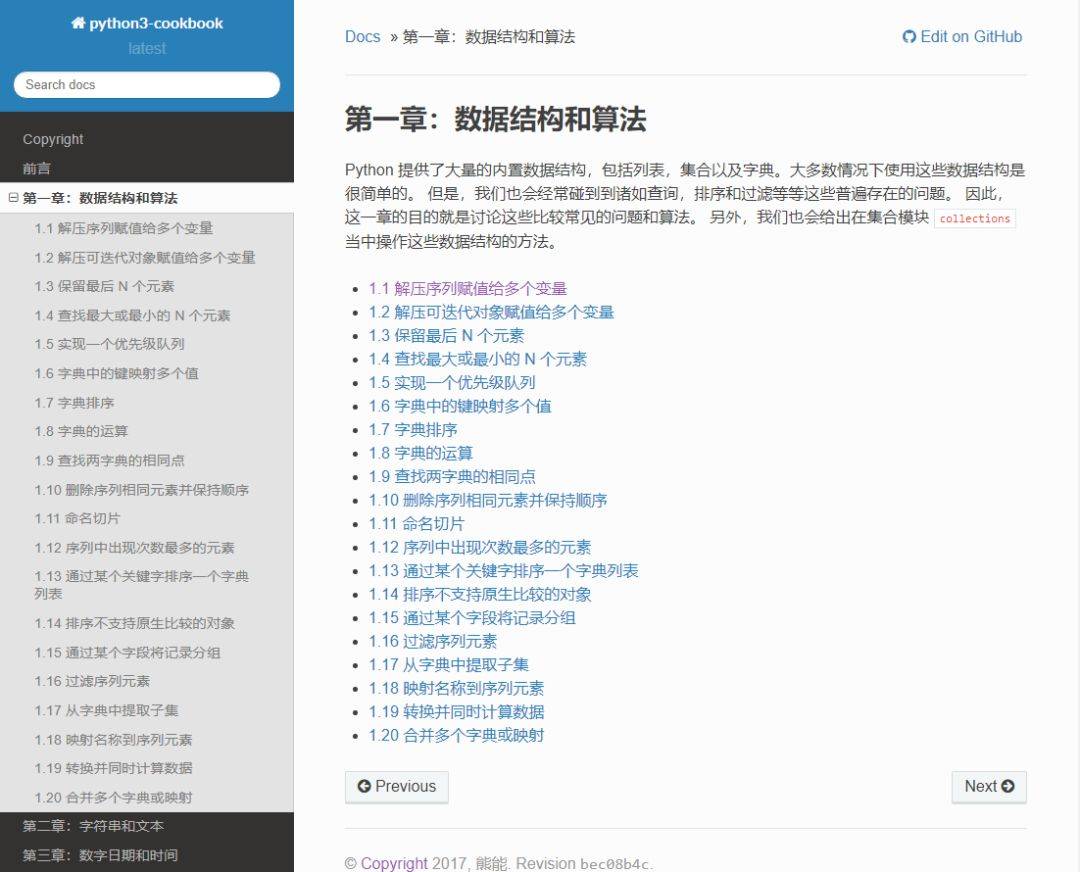
包括一些github的项目也纷纷将教程链接指向这个网站。经过一番查找,该网站是一个可以创建、托管和浏览文档的网站,其网址为:https://readthedocs.org 。在上面可以找到很多优质的资源。
该网站虽然提供了下载功能,但是有些教程并没有提供PDF格式文件的下载,如图:
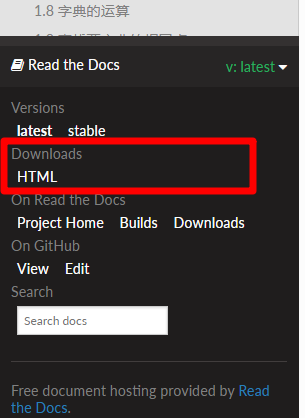
该教程只提供了 HTML格式文件的下载,还是不太方便查阅,那就让我们动手将其转成PDF吧!
2、准备工作
2.1 软件安装
由于我们是要把html转为pdf,所以需要手动wkhtmltopdf 。Windows平台直接在 http://wkhtmltopdf.org/downloads.html 下载稳定版的 wkhtmltopdf 进行安装,安装完成之后把该程序的执行路径加入到系统环境 $PATH 变量中,否则 pdfkit 找不到 wkhtmltopdf 就出现错误 “No wkhtmltopdf executable found”。Ubuntu 和 CentOS 可以直接用命令行进行安装
$ sudo apt-get install wkhtmltopdf # ubuntu
$ sudo yum intsall wkhtmltopdf # centos
2.2 库安装
-
pip install requests # 用于网络请求
-
pip install beautifulsoup4 # 用于操作html
-
pip install pdfkit # wkhtmltopdf 的Python封装包
-
pip install PyPDF2 # 用于合并pdf
3、爬取内容
本文的目标网址为:http://python3-cookbook.readthedocs.io/zh_CN/latest/ 。
3.1 获取教程名称
页面的左边一栏为目录,按F12调出开发者工具并按以下步骤定位到目录元素:
① 点击开发者工具左上角"选取页面元素"按钮;
② 用鼠标点击左上角教程名称处。
通过以上步骤即可定位到目录元素,用图说明:
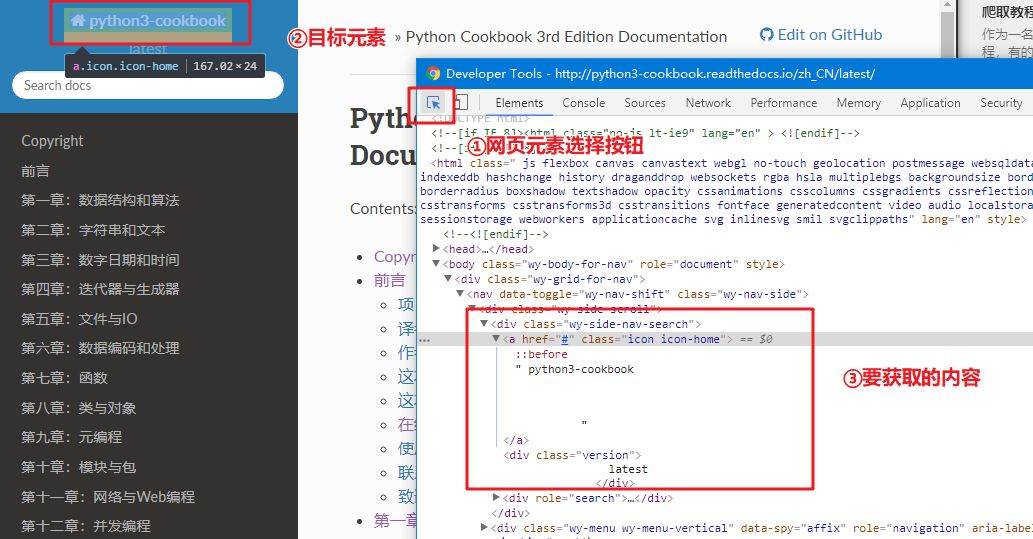
从图看到我们需要的教程名称包含在<div class="wy-side-nav-search"></div>之间的a标签里。假设我们已经获取到了网页内容为html,可以使用以下代码获取该内容:
book_name = soup.find('div', class_='wy-side-nav-search').a.text
3.2 获取目录及对应网址
使用与 2.1 相同的步骤来获取:
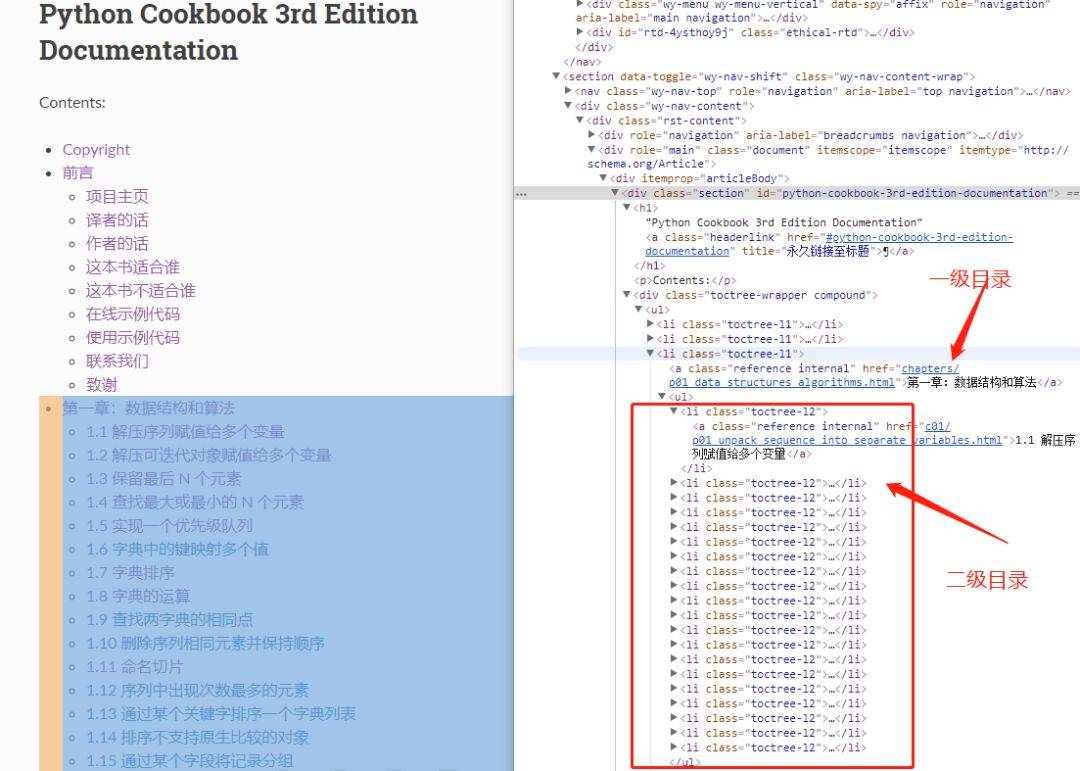
从图看到我们需要的目录包含在<div class="section"></div>之间,<li class="toctree-l1"></li>标签里为一级目录及网址;<li class="toctree-l2"></li>标签里为二级目录及网址。当然这个url是相对的url,前面还要拼接http://python3-cookbook.readthedocs.io/zh_CN/latest/。
使用BeautifulSoup进行数据的提取:
# 全局变量
base_url = 'http://python3-cookbook.readthedocs.io/zh_CN/latest/'
book_name = ''
chapter_info = []
def parse_title_and_url(html):
"""
解析全部章节的标题和url
:param html: 需要解析的网页内容
:return None
"""
soup = BeautifulSoup(html, 'html.parser')
# 获取书名
book_name = soup.find('div', class_='wy-side-nav-search').a.text
menu = soup.find_all('div', class_='section')
chapters = menu[0].div.ul.find_all('li', class_='toctree-l1')
for chapter in chapters:
info = {}
# 获取一级标题和url
# 标题中含有'/'和'*'会保存失败
info['title'] = chapter.a.text.replace('/', '').replace('*', '')
info['url'] = base_url + chapter.a.get('href')
info['child_chapters'] = []
# 获取二级标题和url
if chapter.ul is not None:
child_chapters = chapter.ul.find_all('li')
for child in child_chapters:
url = child.a.get('href')
# 如果在url中存在'#',则此url为页面内链接,不会跳转到其他页面
# 所以不需要保存
if '#' not in url:
info['child_chapters'].append({
'title': child.a.text.replace('/', '').replace('*', ''),
'url': base_url + child.a.get('href'),
})
chapter_info.append(info)
代码中定义了两个全局变量来保存信息。章节内容保存在chapter_info列表里,里面包含了层级结构,大致结构为:
[
{
'title': 'first_level_chapter',
'url': 'www.xxxxxx.com',
'child_chapters': [
{
'title': 'second_level_chapter',
'url': 'www.xxxxxx.com',
}
...
]
}
...
]
3.3 获取章节内容
还是同样的方法定位章节内容:
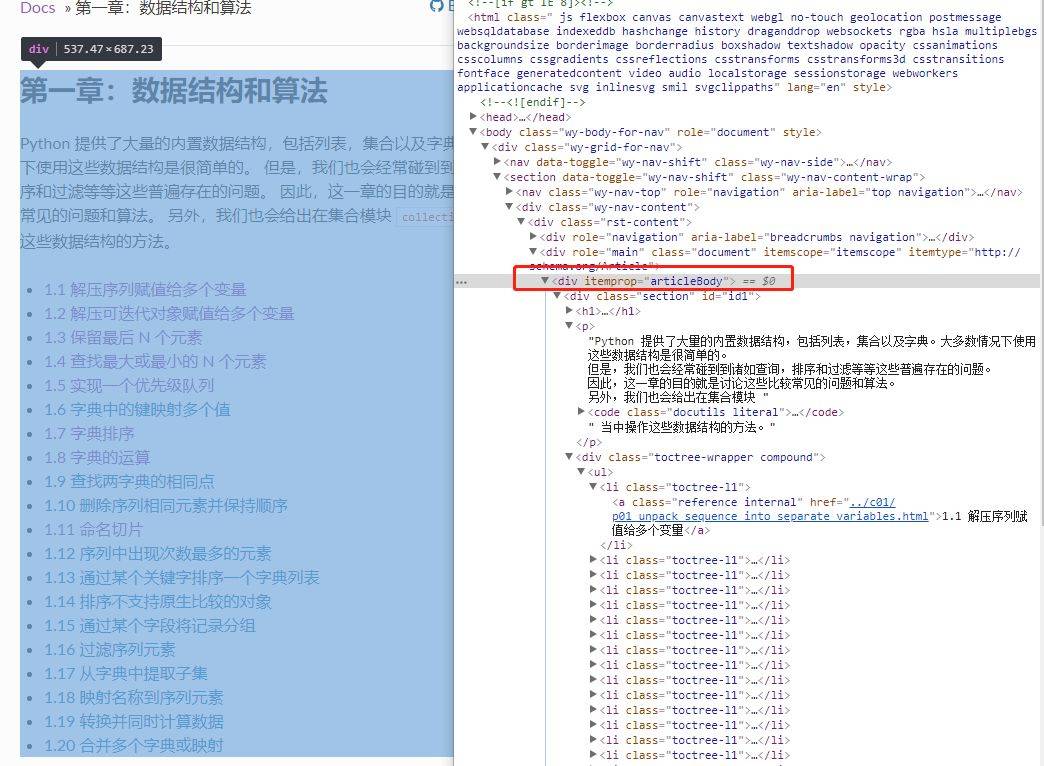
代码中我们通过itemprop这个属性来定位,好在一级目录内容的元素位置和二级目录内容的元素位置相同,省去了不少麻烦。
html_template = """
<!DOCTYPE html>
<html lang="en">
<head>
<meta charset="UTF-8">
</head>
<body>
{content}
</body>
</html>
"""
def get_content(url):
"""
解析URL,获取需要的html内容
:param url: 目标网址
:return: html
"""
html = get_one_page(url)
soup = BeautifulSoup(html, 'html.parser')
content = soup.find('div', attrs={'itemprop': 'articleBody'})
html = html_template.format(content=content)
return html
3.4 保存pdf
def save_pdf(html, filename):
"""
把所有html文件保存到pdf文件
:param html: html内容
:param file_name: pdf文件名
:return:
"""
options = {
'page-size': 'Letter',
'margin-top': '0.75in',
'margin-right': '0.75in',
'margin-bottom': '0.75in',
'margin-left': '0.75in',
'encoding': "UTF-8",
'custom-header': [
('Accept-Encoding', 'gzip')
],
'cookie': [
('cookie-name1', 'cookie-value1'),
('cookie-name2', 'cookie-value2'),
],
'outline-depth': 10,
}
pdfkit.from_string(html, filename, options=options)
def parse_html_to_pdf():
"""
解析URL,获取html,保存成pdf文件
:return: None
"""
try:
for chapter in chapter_info:
ctitle = chapter['title']
url = chapter['url']
# 文件夹不存在则创建(多级目录)
dir_name = os.path.join(os.path.dirname(__file__), 'gen', ctitle)
if not os.path.exists(dir_name):
os.makedirs(dir_name)
html = get_content(url)
padf_path = os.path.join(dir_name, ctitle + '.pdf')
save_pdf(html, os.path.join(dir_name, ctitle + '.pdf'))
children = chapter['child_chapters']
if children:
for child in children:
html = get_content(child['url'])
pdf_path = os.path.join(dir_name, child['title'] + '.pdf')
save_pdf(html, pdf_path)
except Exception as e:
print(e)
3.5 合并pdf
经过上一步,所有章节的pdf都保存下来了,最后我们希望留一个pdf,就需要合并所有pdf并删除单个章节pdf。
from PyPDF2 import PdfFileReader, PdfFileWriter
def merge_pdf(infnList, outfn):
"""
合并pdf
:param infnList: 要合并的PDF文件路径列表
:param outfn: 保存的PDF文件名
:return: None
"""
pagenum = 0
pdf_output = PdfFileWriter()
for pdf in infnList:
# 先合并一级目录的内容
first_level_title = pdf['title']
dir_name = os.path.join(os.path.dirname(
__file__), 'gen', first_level_title)
padf_path = os.path.join(dir_name, first_level_title + '.pdf')
pdf_input = PdfFileReader(open(padf_path, 'rb'))
# 获取 pdf 共用多少页
page_count = pdf_input.getNumPages()
for i in range(page_count):
pdf_output.addPage(pdf_input.getPage(i))
# 添加书签
parent_bookmark = pdf_output.addBookmark(
first_level_title, pagenum=pagenum)
# 页数增加
pagenum += page_count
# 存在子章节
if pdf['child_chapters']:
for child in pdf['child_chapters']:
second_level_title = child['title']
padf_path = os.path.join(dir_name, second_level_title + '.pdf')
pdf_input = PdfFileReader(open(padf_path, 'rb'))
# 获取 pdf 共用多少页
page_count = pdf_input.getNumPages()
for i in range(page_count):
pdf_output.addPage(pdf_input.getPage(i))
# 添加书签
pdf_output.addBookmark(
second_level_title, pagenum=pagenum, parent=parent_bookmark)
# 增加页数
pagenum += page_count
# 合并
pdf_output.write(open(outfn, 'wb'))
# 删除所有章节文件
shutil.rmtree(os.path.join(os.path.dirname(__file__), 'gen'))
本来PyPDF2库中有一个类PdfFileMerger专门用来合并pdf,但是在合并过程中会抛出异常,网上有人也遇到同样的问题,解决办法是修改库源码,本着“不动库源码”的理念,毅然选择了上面这种比较笨的办法,代码还是比较好理解的。
经过以上几个步骤,我们想要的pdf文件已经生成,一起来欣赏一下劳动成果:
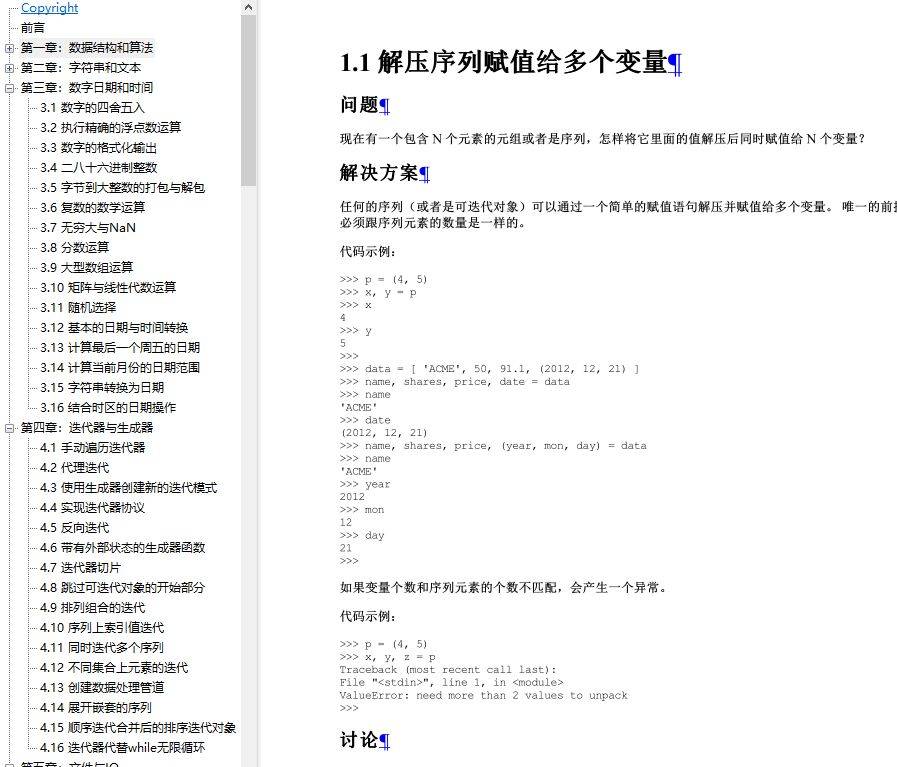
文章来源: C与Python实战
- 还没有人评论,欢迎说说您的想法!
